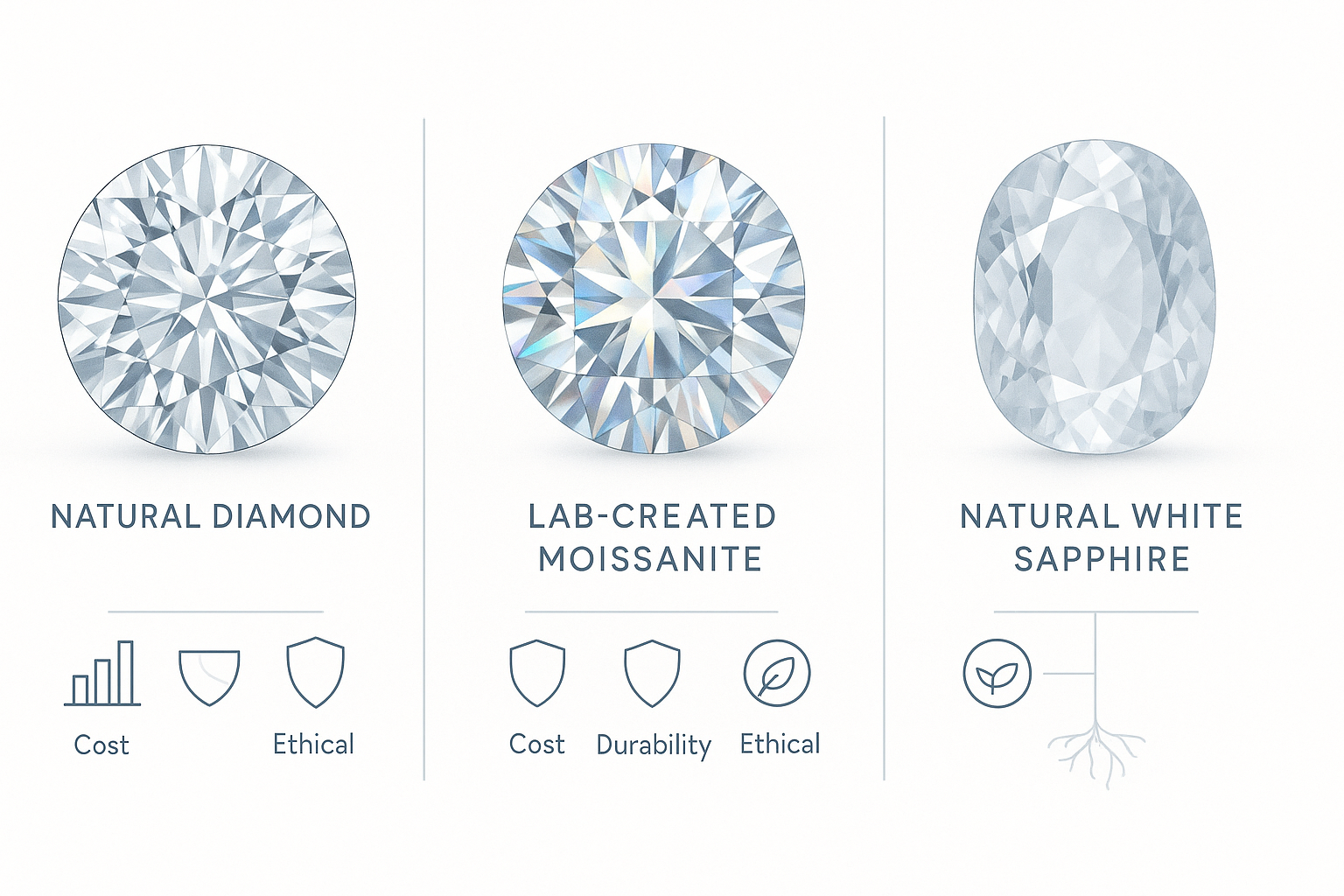
Your opinion is important to us!
Help us improve by filling our quick survey

7
Mins Read
|
November 10, 2025
As a jeweler, you stand at the intersection of tradition, trends, and client expectations. Today’s customers are more informed than ever, asking not just about sparkle and price, but about origin, ethics, and long-term value. The rise of diamond alternatives isn't just a trend; it's a fundamental market shift. The sustainable jewelry market is projected to hit $97.8 billion by 2032, driven by a new generation that prioritizes transparency as much as beauty.
Navigating this new landscape—balancing the timeless appeal of diamonds, the fiery brilliance of moissanite, and the natural elegance of white sapphires—is critical for your business. This guide moves beyond surface-level consumer advice to give you the B2B insights you need: a clear-eyed comparison of wholesale cost, real-world durability, and the increasingly important differentiator of ethical sourcing.
Before we dive deep, here’s a high-level comparison tailored for the jeweler's perspective. Think of this as your quick reference for client conversations and inventory planning.
CriteriaNatural DiamondMoissanite (Lab-Grown)Natural White SapphireDurability (Mohs)10 (The hardest natural mineral)9.25 (Extremely durable, suitable for daily wear)9 (Excellent durability, ideal for all jewelry types)Brilliance & FireHigh brilliance, classic sparkleHighest refractive index, "disco-ball" fireSubdued, elegant brilliance; a bright, icy glowWholesale CostHighest price pointSignificantly lower than diamond, but prices are decliningMost cost-effective natural option, stable pricingSourcingMinedLab-createdMinedEthical NuanceKimberley Process has known limitationsConflict-free by creation, but lacks supply chain transparencyVerifiable traceability from mine to market is possibleKey B2B AngleTraditional prestige, established demandBudget-friendly brilliance, meets sparkle demandNatural origin, ethical story, and value proposition
Understanding the subtle differences is key to guiding your clients toward a choice they'll love for a lifetime—and one that reflects well on your brand.
For centuries, diamonds have been the undisputed symbol of luxury and commitment. Their allure is rooted in both their breathtaking sparkle and their remarkable hardness.
Originally discovered in a meteor crater, the moissanite used in jewelry today is exclusively lab-grown silicon carbide. It has rapidly gained popularity as a diamond alternative due to its dazzling fire and accessible price.
As a member of the corundum family, the same mineral as ruby and blue sapphire, white sapphire is a naturally occurring, durable, and beautiful gemstone. It offers a distinct value proposition for the modern, conscientious buyer.
Let's move beyond the gemological properties and look at the factors that directly impact your bottom line and brand reputation.
Your ability to manage inventory and offer competitive pricing hinges on understanding the wholesale market.
Hardness isn't just a number; it's a promise of longevity to your client. While diamond is the hardest (10), it's important to remember the Mohs scale isn't linear. A diamond is significantly harder than corundum (sapphire).
However, with a hardness of 9, sapphire is exceptionally resilient to scratches and chipping, making it one of the most durable natural materials available and perfectly suited for everyday wear. The key is client education. Reassure them that a white sapphire is a legacy-quality stone, and provide simple care instructions to maintain its brilliance.
In a market saturated with options, your brand's values are your competitive advantage. The demand for ethical sourcing is no longer a niche concern; it’s a mainstream expectation.
This is where a transparent supply chain for natural gemstones becomes invaluable. While lab-grown stones are marketed as "ethical," this often overlooks the energy consumption of labs and the lack of transparency in their own supply chains.
At Ceylons, we built our business on the principle of "Fine & Fair Sapphires." Our direct involvement in mining operations in Sri Lanka, our commitment to CO2-neutral practices, and our Female Empowered Lapidary aren't just marketing points—they are verifiable facts. When you source a white sapphire from us, you’re not just buying a stone; you’re offering your clients a piece of a positive story. You can confidently explain where their gem came from and how its journey empowered a community. This is a level of transparency that builds immense trust and brand loyalty.
The best gemstone for your inventory isn't just one stone—it's a curated collection that meets the diverse needs of your clientele.
By incorporating ethically sourced white sapphires into your offerings, you differentiate your brand, cater to a growing and influential market segment, and build a business that is as resilient and beautiful as the gems you sell.
Will my clients be disappointed by a white sapphire's sparkle compared to a diamond?
It's all about framing the conversation correctly. Don't position it as a "lesser" sparkle, but a "different" one. Describe it as a "crisp, icy brilliance" or a "soft, elegant glow." Many clients prefer this understated look to the fiery flash of a diamond or moissanite. Show them high-quality examples side-by-side.
How do I address the cleaning requirements for white sapphires?
Be proactive and positive. Frame it as simple, routine care, just like cleaning any other fine jewelry. Provide a complimentary cleaning cloth and simple instructions (a soft brush with warm, soapy water) as a value-added service. This demonstrates your expertise and commitment to the client's long-term satisfaction.
Is there a significant difference in how I should set a white sapphire versus a diamond?
No. Due to its excellent hardness and durability, a white sapphire can be set in any style you would use for a diamond, including delicate pavé or secure bezel settings. Its toughness makes it a reliable and versatile choice for your designs. Understanding these basic facts about sapphires will give you confidence in your recommendations.
Sign up to our newsletter now and get it directly to your mailbox.
CEYLONS | MUNICH stands for the finest Ceylon sapphires. A brand committed to responsible mining of Sri Lankan gemstones obtained in an ethical manner.